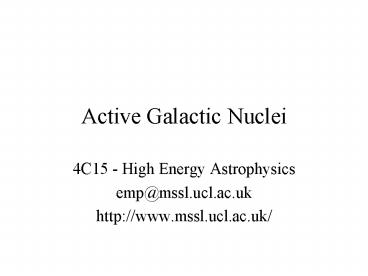Active Galactic Nuclei - PowerPoint PPT Presentation
Title:
Active Galactic Nuclei
Description:
Quasars - finding their mass. The Eddington Limit ... So a measurement of quasar luminosity gives the minimum mass. Measuring a quasar's black hole ... – PowerPoint PPT presentation
Number of Views:28
Avg rating:3.0/5.0
Title: Active Galactic Nuclei
1
Active Galactic Nuclei
- 4C15 - High Energy Astrophysics
- emp_at_mssl.ucl.ac.uk
- http//www.mssl.ucl.ac.uk/
2
Introduction
- Apparently stellar
- Non-thermal spectra
- High redshifts
- Seyferts (usually found in spiral galaxies)
- BL Lacs (normally found in ellipticals)
- Quasars (nucleus outshines its host galaxy)
3
Quasars
- Animation of a quasar
This animation takes you on a tour of a quasar
from beyond the galaxy, right up to the edge of
the black hole.
It covers ten orders of magnitude, ie the last
frame covers a distance 10 billion times smaller
than the first.
4
Quasars - Monsters of the Universe
- Artists
impression
5
AGN Accretion
- Believed to be powered by accretion onto
supermassive black hole
high luminosities
highly variable
Eddington limit gt large mass
small source size
Accretion onto supermassive black hole
6
Quasars - finding their mass
- The Eddington Limit
Where inward force of gravity balances the
outward push of radiation on the surrounding
gas.
L
mass
Edd
So a measurement of quasar luminosity gives the
minimum mass
7
Measuring a quasars black hole
- Light travel time effects
If photons leave A and B at the same time, A
arrives at the observer a time t ( d / c )
later.
A
B
If an event happens at A and takes a time dt,
then we see a change over a timescale tdt. This
gives a maximum value for the diameter, d,
because we know that our measured timescale must
be larger than the light crossing time.
d c x t
c speed of light
d diameter
8
Accretion disk and black hole
- In the very inner regions, gas is believed to
form a disk to rid itself of angular momentum
The disk is about the size of our Solar System.
It is geometrically thin and optically-thick and
radiates like a collection of blackbodies, very
hot towards the centre (emitting soft X-rays) and
cool at the edges (emitting optical/IR).
9
Accretion rates
- Calculation of required accretion rate
.
10
Accretion disk structure
- The accretion disk (AD) around a star can be
considered as rings or annuli of blackbody
emission. R is the stars radius.
11
Disk temperature
- Thus temperature as a function of radius T(R)
We define the boundary condition T at radius R
gt
12
Disk spectrum
- Flux as a function of frequency, n -
Total disk spectrum
Log nFn
Annular BB emission
Log n
13
Black hole and accretion disk
The innermost stable orbit occurs at
When
14
High energy spectra of AGN
- Spectrum from the optical to medium X-rays
Low-energy disk tail
Comptonized disk
Balmer cont, FeII lines
high-energy disk tail
Log nFn
optical UV EUV soft X-rays X-rays
14 15 16
17 18
Log n
15
FeKa line
- Fluorescence line observed in Seyferts from gas
with temp of at least a million degrees.
FeKa
X-ray
e-
16
Source of fuel
- interstellar gas
- infalling stars
- remnant of gas cloud which originally
formed black hole - high acc rate necessary if z cosmological -
otherwise not required if nearby
17
The Big Bang and redshift
- All galaxies are moving away from us. This is
consistent with an expanding Universe, following
its creation in the Big Bang.































